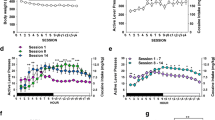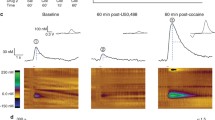Abstract
Rationale
Effects of synthetic kappa opioid receptor agonists on cocaine-induced reward have been studied extensively in rats but relatively few studies have used the endogenous kappa agonist dynorphin A(1–17).
Objectives
Three studies were conducted to examine the effect of the natural sequence dynorphin on cocaine-induced increases in dopamine, on the formation of conditioned place preference and on increases in locomotor activity in C57BL/6 J mice.
Methods
After implantation of guide cannulae into the caudate putamen, mice were allowed 4–5 days to recover from surgery. In the first study, dynorphin A (0, 1, 2, 4.4 nmol) was infused into the caudate putamen and dopamine levels were measured by in vivo microdialysis in that brain region. Then, the effect of dynorphin A (4.4 nmol) on increases in dopamine levels induced by 15 mg/kg cocaine i.p. was also measured with in vivo microdialysis. The third experiment examined the effect of dynorphin A (4.4 nmol) on conditioned place preference and locomotion induced by 15 mg/kg cocaine.
Results
Dynorphin A significantly decreased basal dopamine levels in a dose-dependent manner by more than 60% at the highest dose, and this effect was completely blocked by pre-injection of the kappa-opioid receptor antagonist nor-BNI (10 mg/kg). The highest dose of dynorphin (4.4 nmol) blocked increases in dopamine levels, the formation of conditioned place preference and attenuated locomotion induced by 15 mg/kg cocaine.
Conclusion
The blockade of the cocaine-induced rise in striatal dopamine may contribute to both dynorphin’s ability to prevent the development of cocaine-induced conditioned place preference and to attenuate the increase in locomotor activity.





Similar content being viewed by others
References
Bals-Kubik R, Herz A, Shippenberg TS (1989) Evidence that the aversive effects of opioid antagonists and kappa-agonists are centrally mediated. Psychopharmacology 98:203–206
Claye LH, Maisonneuve IM, Yu J, Ho A, Kreek MJ (1996) Local perfusion of dynorphin A1–17 reduces extracellular dopamine levels in the nucleus accumbens. NIDA Res Monogr 174:113
Crawford CA, McDougall SA, Bolanos CA, Hall S, Berger SP (1995) The effects of the kappa agonist U-50,488 on cocaine-induced conditioned and unconditioned behaviors and Fos immunoreactivity. Psychopharmacology 120:392–399
Daunais JB, McGinty JF (1995) Cocaine binges differentially alter striatal preprodynorphin and zif/268 mRNAs. Brain Res Mol Brain Res 29:201–210
Daunais JB, Roberts DC, McGinty JF (1993) Cocaine self-administration increases preprodynorphin, but not c-fos, mRNA in rat striatum. Neuroreport 4:543–546
Di Chiara G, Imperato A (1988) Drugs abused by humans preferentially increase synaptic dopamine concentrations in the mesolimbic system of freely moving rats. Proc Natl Acad Sci USA 85:5274–5278
Franklin KBJ, Paxinos G (1997) The mouse brain in stereotaxic coordinates. Academic Press, New York, NY
Gerfen CR, Engber TM, Mahan LC, Susel Z, Chase TN, Monsma FJ Jr, Sibley DR (1990) D1 and D2 dopamine receptor-regulated gene expression of striatonigral and striatopallidal neurons. Science 250:1429–1432
Glick SD, Maisonneuve IM, Raucci J, Archer S (1995) Kappa opioid inhibition of morphine and cocaine self-administration in rats. Brain Res 681:147–152
Glick SD, Visker KE, Maisonneuve IM (1998) Effects of cyclazocine on cocaine self-administration in rats. Eur J Pharmacol 357:9–14
Heidbreder CA, Shippenberg TS (1994) U-69593 prevents cocaine sensitization by normalizing basal accumben dopamine. Neuroreport 5:1797–1800
Heidbreder CA, Goldberg SR, Shippenberg TS (1993) The kappa-opioid receptor agonist U-69593 attenuates cocaine-induced behavioral sensitization in the rat. Brain Res 616:335–338
Hurd YL, Herkenham M (1993) Molecular alterations in the neostriatum of human cocaine addicts. Synapse 13:357–369
Hurd YL, Brown EE, Finlay JM, Fibiger HC, Gerfen CR (1992) Cocaine self-administration differentially alters mRNA expression of striatal peptides. Brain Res Mol Brain Res 13:165–170
Kalivas PW (1993) Neurotransmitter regulation of dopamine neurons in the ventral tegmental area. Brain Res Brain Res Rev 18:75–113
King AC, Ho A, Schluger J, Borg L, Kreek MJ (1999) Acute subjective effects of dynorphin A(1–13) infusion in normal healthy subjects. Drug Alcohol Dependence 54:87–90
Kreek MJ, Schluger J, Borg K, Gunduz, M, Ho A (1999) Dynorphin A1–13 causes elevation of serum levels of prolactin through an opioid receptor mechanism in humans: gender differences and implications for modulation of dopaminergic tone in the treatment of addiction. J Pharmacol Exp Ther 288:261–269
Kreek MJ, LaForge KS, Butelman E (2002) Pharmacotherapy of addictions. Nat Rev Drug Discov 1:710–726
Kuzmin AV, Semenova S, Gerrits MA, Zvartau EE, Van Ree JM (1997) Kappa-opioid receptor agonist U50,488H modulates cocaine and morphine self-administration in drug-naive rats and mice. Eur J Pharmacol 321:265–271
Maisonneuve IM, Archer S, Glick SD (1994) U50,488, a kappa opioid receptor agonist, attenuates cocaine-induced increases in extracellular dopamine in the nucleus accumbens of rats. Neurosci Lett 181:57–60
Mansour A, Hoversten MT, Taylor LP, Watson SJ, Akil H (1995) The cloned μ, δ and κ receptors and their endogenous ligands: evidence for two opioid peptide recegnition cores. Brain Res 700:89–98
Mathieu-Kia AM, Besson MJ (1998) Repeated administration of cocaine, nicotine and ethanol: effects on preprodynorphin, preprotachykinin A and preproenkephalin mRNA expression in the dorsal and the ventral striatum of the rat. Brain Res Mol Brain Res 54:141–151
Mori T, Nomura M, Nagase H, Narita M, Suzuki T (2002) Effects of a newly synthesized kappa-opioid receptor agonist, TRK-820 on the discriminative stimulus and rewarding effects of cocaine in rats. Psychopharmacology 161:17–22
National Research Council (1996) Guide for the care and use of laboratory animals. Institute of Laboratory Animal Resources Commission on Life Sciences, National Academy of Sciences, Washington, D.C.
Portenoy RK, Caraceni A, Cherny NI, Goldblum R, Ingham J, Inturrisi CE, Johnson JH, Lapin J, Tiseo PJ, Kreek MJ (1999) Dynorphin A(1–13) analgesia in opioid-treated patients with chronic pain: a controlled pilot study. Clin Drug Invest 17:33–42
Raynor K, Kong H, Chen Y, Yasuda K, Yu L, Bell GI, Reisine T (1994) Pharmacological characterization of the cloned κ-, δ-, and μ- opioid receptors. Mol Pharmacol 45:330–334
Reed B, Zhang Y, Chait BT, Kreek MJ (2003) Dynorphin A (1–17) biotransformation in striatum of freely moving rats using microdialysis and matrix-assisted laser desorption/ionization mass spectrometry. J Neurochem 86:815–823
Reisine T (1995) Opiate receptors. Neuropharmacology 34:463–472
Remmers AE, Clark MJ, Mansour A, Akil H, Woods JH, Medzihradsky F (1999) Opioid efficacy in a C6 glioma cell line stably expressing the human kappa opioid receptor. J Pharmacol Exp Ther 288:827–833
Schenk S, Partridge B, Shippenberg TS (1999) U69593, a kappa-opioid agonist, decreases cocaine self-administration and decreases cocaine-produced drug-seeking. Psychopharmacology 144:339–346
Shippenberg TS, Herz A (1987) Place preference conditioning reveals the involvement of D1-dopamine receptors in the motivational properties of mu-kappa-opioid agonists. Brain Res 436:169–172
Shippenberg TS, LeFevour A, Heidbreder C (1996) Kappa-opioid receptor agonists prevent sensitization to the conditioned rewarding effects of cocaine. J Pharmacol Exp Ther 276:545–554
Shippenberg TS, LeFevour A, Thompson AC (1998) Sensitization to the conditioned rewarding effects of morphine and cocaine: differential effects of the kappa-opioid receptor agonist U69593. Eur J Pharmacol 345:27–34
Sivam SP (1989) Cocaine selectively increases striatonigral dynorphin levels by a dopaminergic mechanism. J Pharmacol Exp Ther 250:818–824
Smith JD, Loughlin SE, Leslie FM (1992) Kappa-opioid inhibition of [3H] dopamine release from rat ventral mesencephalic dissociated cell cultures. Mol Pharmacol 42:575–583
Smith MA, Gordon KA, Craig CK, Bryant PA, Ferguson ME, French AM, Gray JD, McClean JM, Tetirick JC (2003) Interactions between opioids and cocaine on locomotor activity in rats: influence of an opioid’s relative efficacy at the mu receptor. Psychopharmacology 167:265–273
Spanagel R, Herz A, Shippenberg TS (1992) Opposing tonically active endogenous opioid systems modulate the mesolimbic dopaminergic pathway. Proc Natl Acad Sci U S A 89:2046–2050
Spangler R, Unterwald EM, Kreek MJ (1993) “Binge” cocaine administration induces a sustained increase of prodynorphin mRNA in rat caudate-putamen. Brain Res Mol Brain Res 19:323–327
Specker S, Wananukul W, Hatsukami D, Nolin K, Hooke L, Kreek MJ, Pentel PR (1998) Effects of dynorphin A(1–13) on opiate withdrawal in humans. Psychopharmacology 137:326–332
Suzuki T, Shiozaki Y, Masukawa Y, Misawa M, Nagase H (1992) The role of mu-and kappa- opioid receptors in cocaine-induced conditioned place preference. Jpn J Pharmacol 58:435–442
Thompson AC, Zapata A, Justice JB Jr, Vaughan RA, Sharpe LG, Shippenberg TS (2000) Κ-opioid receptor activation modifies dopamine uptake in the nucleus accumbens and opposes the effects of cocaine. J Neurosci 20:9333–9340
Turchan J, Przewlocka B, Lason W, Przewlocki R (1998) Effects of repeated psychostimulant administration on the prodynorphin system activity and kappa opioid receptor density in the rat brain . Neuroscience 85:1051–1059
Wiechman BE, Wood TE, Spratto GR (1981) Locomotor activity in morphine-treated rats: effects of and comparisons between cocaine, procaine, and lidocaine. Pharmacol Biochem Behav 15:425–433
Yuferov V, Zhou Y, LaForge KS, Spangler R, Ho A, Kreek MJ (2001) Elevation of guinea pig brain preprodynorphin mRNA expression and hypothalamic-pituitary-adrenal axis activity by “binge” pattern cocaine administration. Brain Res Bull 55:65–70
Zhang Y, Schlussman SD, Ho A, Kreek MJ (2001) Effect of acute binge cocaine on levels of extracellular dopamine in the caudate putamen and nucleus accumbens in male C57BL/6 J and 129/J mice. Brain Res 921:172–177
Zhang Y, Butelman ER, Schlussman SD, Ho A, Kreek MJ (2003) Effect of the κ opoid agonist R-84760 on cocaine-induced increases in striatal dopamine levels and cocaine-induced place preference in C57BL/6J mice. Psychopharmacology (in press)
Zhu J, Luo LY, Li JG, Chen CG, Liu-Chen LY (1997) Activation of the cloned human kappa opioid receptor by agonists enhances [35S] GTPγS binding to membranes: determination of potencies and efficacies of ligands. J Pharmacol Exp Ther 282:676–684
Acknowledgements
We thank Susan Russo for her careful reading of the manuscript. This work was supported by National Institutes of Health-National Institute on Drug Abuse Research Center Grant P60-DA05130 and National Institute on Drug Abuse Research Scientist Award K05-DA00049 to Mary Jeanne Kreek.
Author information
Authors and Affiliations
Corresponding author
Rights and permissions
About this article
Cite this article
Zhang, Y., Butelman, E.R., Schlussman, S.D. et al. Effect of the endogenous κ opioid agonist dynorphin A(1–17) on cocaine-evoked increases in striatal dopamine levels and cocaine-induced place preference in C57BL/6J mice. Psychopharmacology 172, 422–429 (2004). https://doi.org/10.1007/s00213-003-1688-3
Received:
Accepted:
Published:
Issue Date:
DOI: https://doi.org/10.1007/s00213-003-1688-3




